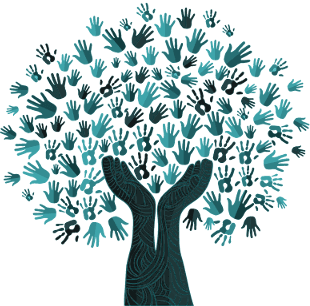Creativity = multisolving + neurodiversity + thinking tools
Creativity allows organisations and individuals to find their niches and thrive in the world. S23M invites you to discover deeper forms of collaboration by transitioning from the information age to the knowledge age.

Creative Collaboration is a subscription service that assists organisations to unlock creativity and to establish and maintain psychological safety on an ongoing basis. It consists of three elements:
-
Multisolving – four or more Open Space workshops per year, to power a continuous SECI (socialisation, externalisation, combination, internalisation) knowledge creation spiral in a distributed team environment that breaks through the barriers of established disciplines, management structures, and physical distance
-
Neurodiversity – access to neurodivergent facilitators and to the creativity of neurodivergent people within your organisation, to question implicit assumptions and to overcome cultural inertia and bias against creativity
- Thinking tools – access to the MODA + MODE repository of knowledge, and via inquiries to our team, access to our collective tacit knowledge from working with more than 100 organisations, as a foundation for critical thinking and creative experimentation
In many industries, psychological safety is already recognised as an important aspect of the overarching topic of safety at work. The ability to talk about mistakes is critical for minimising the risks of accidents – and at the same time it can assist organisations in improving collaboration and in recognising potential opportunities for deep innovation:
- It provides a space for creative freedom
- It unlocks valuable tacit knowledge within the organisation
- It releases the handbrake to collaboration by visibly extending trust to the people within the organisation
- It can be used to repair frayed relationships
- It replaces fear with courage
Would your organisation benefit from Creative Collaboration? Take the online psychological safety survey to find out. Contact us for further information.
What is multisolving in Open Space?
People acquire knowledge or become aware of new information as individuals, and as part of groups of different sizes: households, teams, organisations, communities, societies, and with the help of ubiquitous global communication tools, even collectively as humanity.
Learning takes place at different time scales, dependent on the level of depth of knowledge and understanding that is acquired:
- Observation of an event can enable learning by imitation within a few seconds
- New facts gleaned from a conversation are learned within a few minutes
- Using a non-trivial new tool can take a few days
- Understanding the context of a new role / job may take a few months
- Learning a new discipline / profession takes a few years
- Mastery of a discipline can take several decades
- Understanding the essence of life may take a lifetime

Our Creative Collaboration service makes use of Open Space to break through the barriers of established disciplines and management structures, and to power a continuous SECI (socialisation, externalisation, combination, internalisation) knowledge creation spiral. Open Space workshops and are very effective for unlocking creativity and for establishing and maintaining psychological safety on an ongoing basis, both online and in the physical work environment.
We have successfully used Open Space with our clients since 2002, to catalyse shared understanding across organisational silos and across organisational boundaries, even in the politically charged environments of software standards development and workplace culture in the healthcare sector.

What is neurodiversity?
Neurodiversity is the biological diversity of human brains and minds – the infinite variation in neurocognitive functioning within our species. Neurodivergence is at the core of creativity.

Neurodivergent people and teams:
- Adhere to idiosyncratic moral value systems rather than social norms
- Are okay with exploring ideas that upset the "social order"
- Spend much more time experimenting and implementing ideas that others would consider crazy or a waste of time
- Have atypical life goals: new forms of understanding, making a positive impact, translating ideas into artistic expression
- Autistic people in particular have unusually developed pattern recognition abilities and an unusual ability to persevere
In the Asch conformity experiment, autistic people were found to resist changing their spontaneous judgement to an array of graphic lines despite social pressure to change by conforming to the erroneous judgement of an authoritative confederate.
What are thinking tools?
Thinking tools are the mental image schemas, frames, and reasoning tools, and also the behavioural patterns that help us to validate knowledge, ask new questions, and form and explore new ideas – the hugely diverse set of tools that different people tap into as part of the creative process.
The MODA + MODE approach offers 26 backbone principles as a baseline set of thinking tools to avoid getting entrapped in a single paradigm. The backbone principles have been sourced from a range of sciences and engineering disciplines, including suitable mathematical foundations. A specific organisational culture may have further bones, but one or more missing vertebrae lead to an organisational learning disability.

Even with simple technologies such as whiteboards and markers it is possible to design and use highly expressive and unambiguous visual languages that are much easier for humans to parse and understand than information in a linear audio or text format. MODA + MODE therefore makes extensive use of visual languages and provides guidance for developing further domain specific visual languages.
Example Configurations
- Creative Collaboration (default) – Focus on evolutionary design and creative thinking tools – the hugely diverse set of tools that different people tap into as part of the creative process
- Employee Wellbeing – Creating and maintaining a psychologically and culturally safe environment
- Transdisciplinary Governance – Coordination and crisis management across discipline boundaries in a digitally connected world
- Human Factors, Security and Risk – Human physical limits, cognitive limits such as Dunbar's number, and the impact of fear on collaboration, security and risk exposure
- Enterprise Software Advisor – optimising the value of enterprise software solutions
- Clinical Data Governance – Clinical data governance standards, design of trustworthy and reliable federated clinical data repositories
- Interoperability & System Integration – Model oriented health information interoperability solutions based on FHIR (Fast Healthcare Interoperability Resources) and IPS (International Patient Summary) standards
- Community-Oriented Service Co-design – Developing the creative thinking practices required to address the biggest issues facing coming generations














